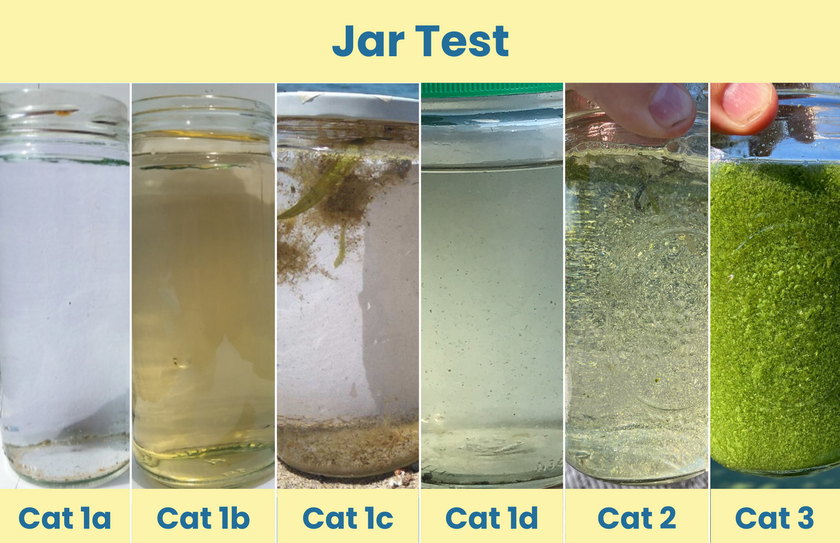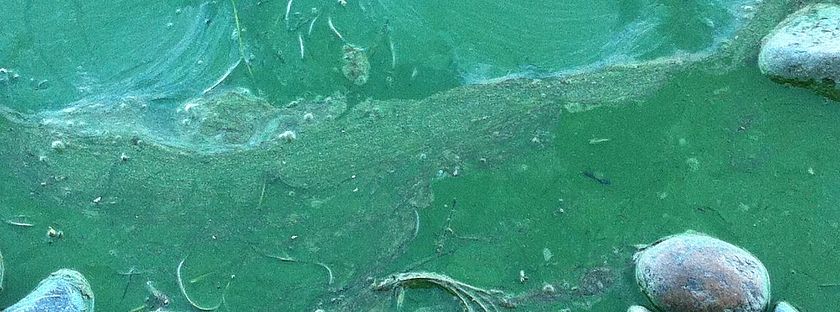
Categorization of Water Conditions
General Instructions
Remember to avoid direct contact with Category 2 and 3 conditions.
All observations that are submitted and approved will be posted on the Vermont Department of Health Cyanobacteria Tracker.
Please make observations at the same location once per week. Routine observations should be made no earlier than 10:00 AM and preferably by 3:00 PM. Blooms most frequently appear during this timeframe because cyanobacteria have had a chance to rise from lower in the water column in response to light and heat. Reports of good conditions outside of this timeframe may be rejected.
Anyone providing reports should include the following information:
- Water Temperature (°F)
- Water Surface
- Calm
- Rolling
- White Caps
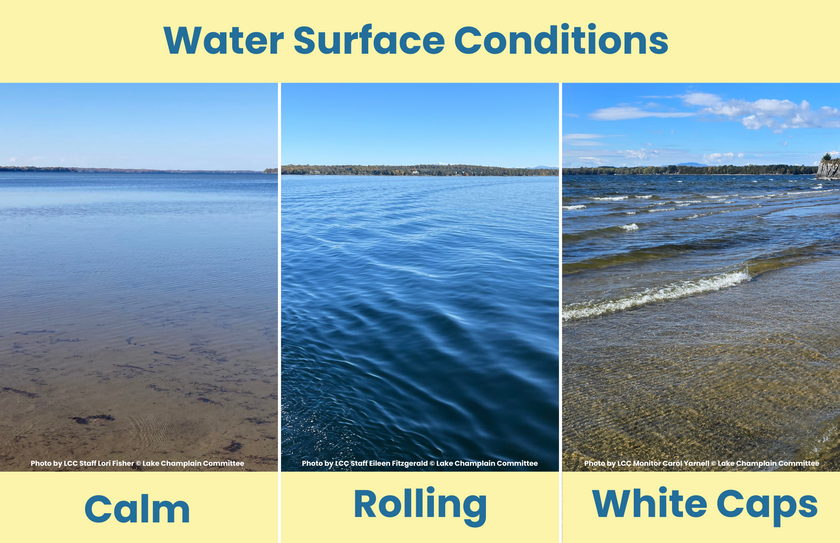
- Water Conditions
The rating scale runs from 1 (a, b, c, or d) to 3, with 1a being no cyanobacteria observed—clear water and 3 being a cyanobacteria bloom observed in progress.
- Category 1a
- Category 1b
- Category 1c
- Category 1d
- Category 2
- Category 3
- Approximately how far along the shore the bloom extends (in feet).
- Approximately how far out into the water the bloom extends (in feet).
- Photographs
- For category 1d, 2, and 3 conditions, three digital photographs should be submitted via the online form:
- Jar
- Close
- Broad
Category 1a: No cyanobacteria observed—clear water
There is high visibility through the water column. Objects lower in the water column―sand, rocks, or plants—are clearly visible. The overall appearance of the water is clear.
What you may observe:
- Foam
- Shed insect skins
- Sporadic plants, like duckweed or American eelgrass
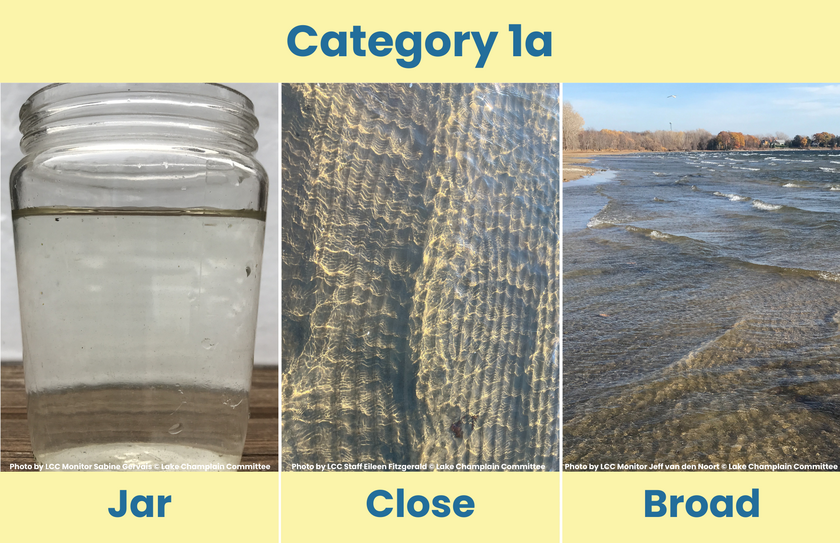

Category 1b: No cyanobacteria observed—brown or turbid water
There is low visibility through the water column. The overall appearance of the water is brown and cloudy.
What you may observe:
- Shades of brown water
- Cloudy water
- Shed insect skins
- Sporadic plants, like duckweed or American eelgrass
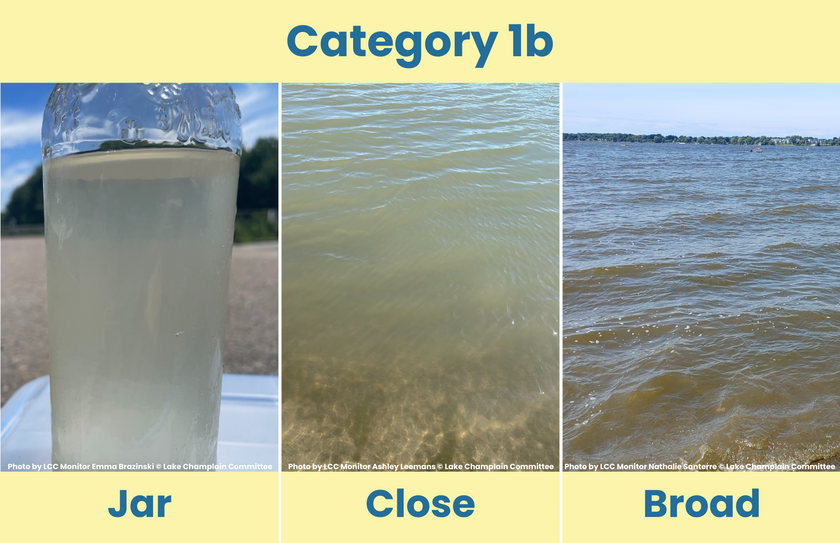
Category 1c: No cyanobacteria observed—other material present
Other material that isn’t cyanobacteria.
What you may observe: Daphnia sp., duckweed, filamentous green algae, iron bacteria, or pollen. See images and descriptions of each phenomenon below.
Daphnia sp.
- What: a genus of planktonic crustaceans, commonly called water fleas; their resting eggs (winter or dry season) are commonly confused with cyanobacteria
- Looks Like: oval seeds
- Color: brown
- Where: the water surface of lakes, bays, ponds, marshes, rivers, and streams
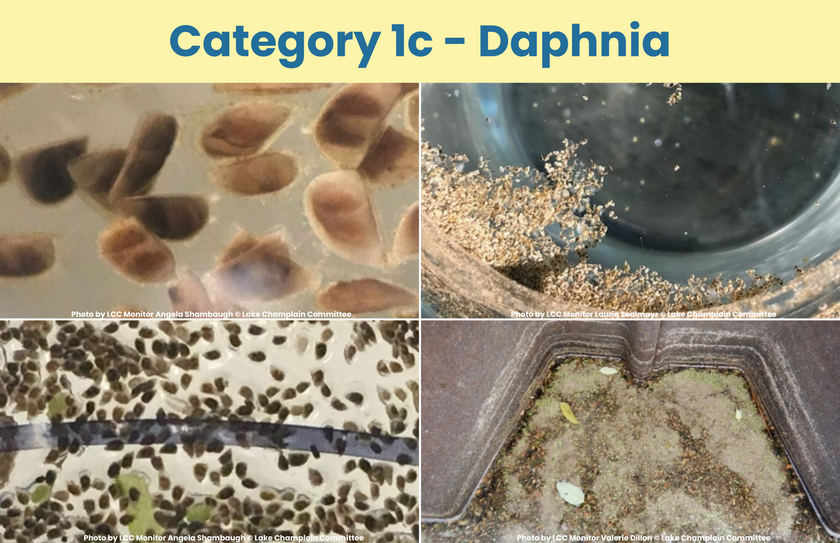
Duckweed
- What: a tiny free-floating aquatic flowering plant
- Looks Like: a miniature lily pad; individual plants often converge to form floating mats
- Color: green
- Where: the water surface of lakes, bays, ponds, marshes, rivers, and streams
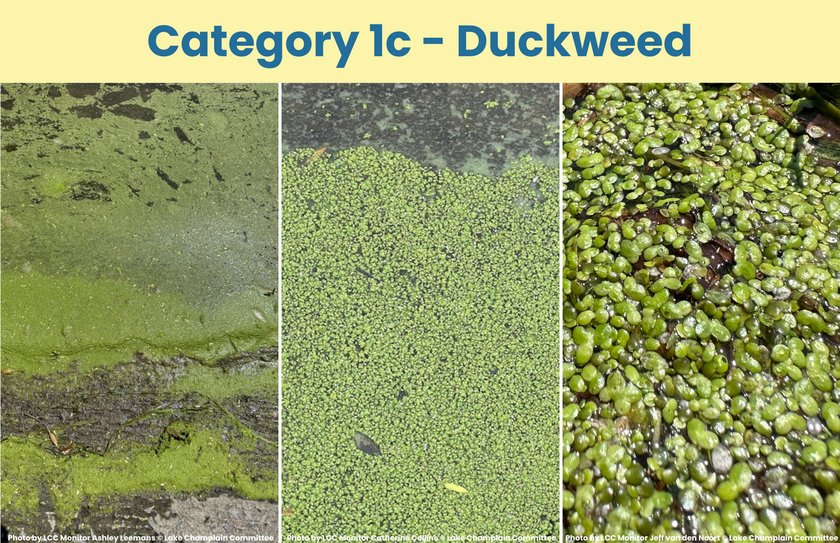
Filamentous Green Algae
- What: a non-toxic group of algae
- Looks Like: stringy, hairy, silky, or clumpy; strands that tangle around paddles or boat hooks; wet fabric attached to rocks or the lake bottom; floating rafts or thick mats of bubbling scum
- Color: green or brown
- Where: the water surface or bottom of lakes, ponds, rivers, and streams; attached to rocks above and below the water
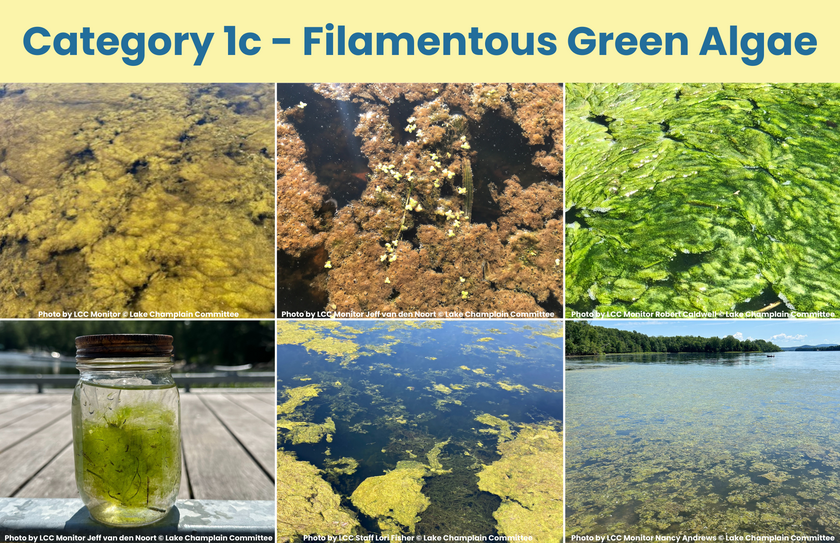
- Not sure if you’re seeing potentially toxic cyanobacteria or non-toxic filamentous green algae? A stick test is a good way to differentiate cyanobacteria from plant matter. If you can pick it up with a stick or paddle, or see plant leaves, it’s generally not cyanobacteria.
- Keep in mind that the stick test is not 100% reliable because some types of cyanobacteria, like Scytonema sp., can be picked up with a stick.
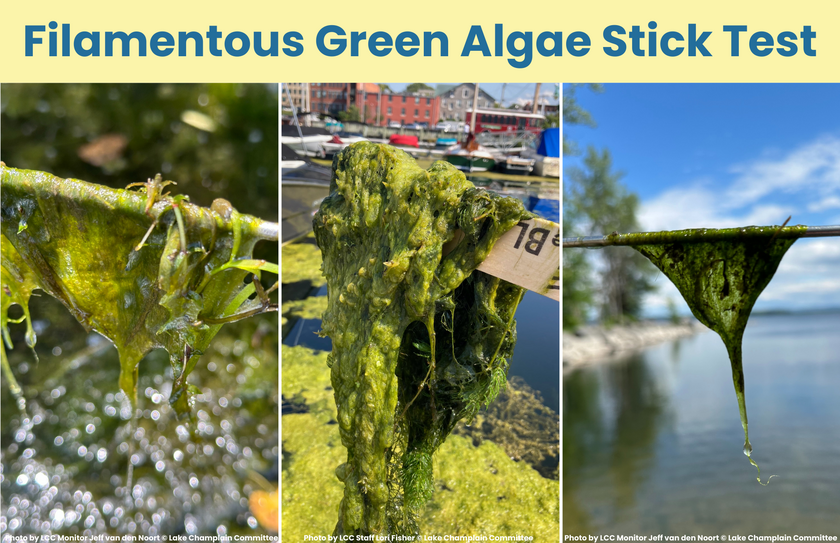
Iron Bacteria
- What: organisms that obtain energy by oxidizing dissolved iron
- Looks Like: red, orange, or brown slime and oily sheens
- Color: red, orange, and brown
- Where: locations that have iron in the soil and are frequently wet

Pollen
- What: a fine, powdery fertilizing element of flowering plants
- Looks Like: a thin film of sawdust on the water
- Color: mustard yellow
- Where: the surface of any body of water, especially at shorelines; accumulating on hard surfaces like vehicle windshields, sidewalks, and parking lots
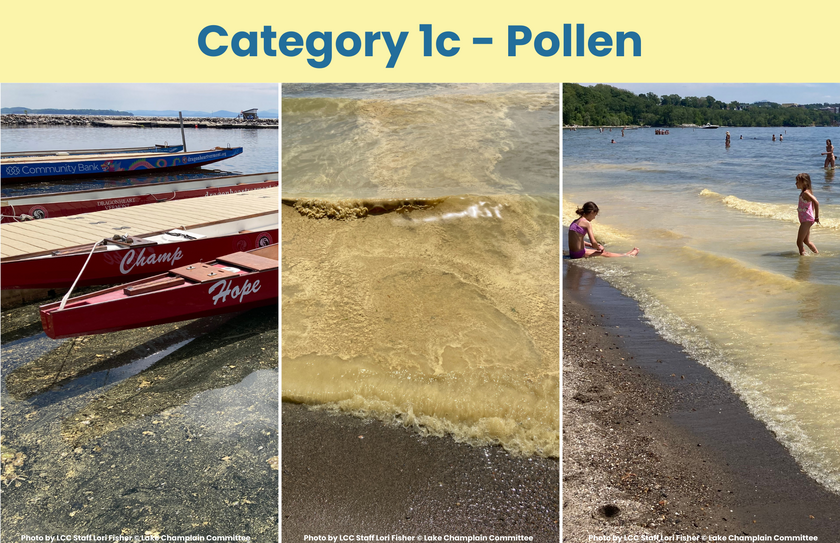
- Cyanobacteria are generally restricted to the water, whereas pollen can show up not only on the waterbody, but also in the vicinity. Reference the image below to see pollen on the windshield of a parked car (left), in a parking lot (middle), and along a shoreline (right).
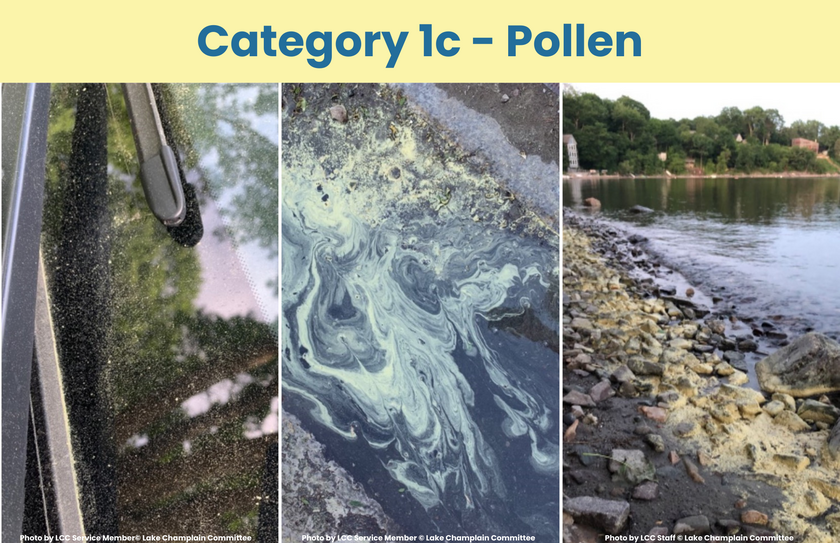
Category 1d: Little cyanobacteria observed—recreation not impaired—tiny specks present, but no streaks or patches—include photos
When cyanobacteria start to be visible in water, they often appear as tiny specks or fuzzy balls; cyanobacteria can occur in densities so low that they do not impair recreational enjoyment of the water.
What you may observe:
- Water can appear clear, but green tiny specks or fuzzy balls may be visible upon close inspection
- No surface or shoreline accumulations of cyanobacteria
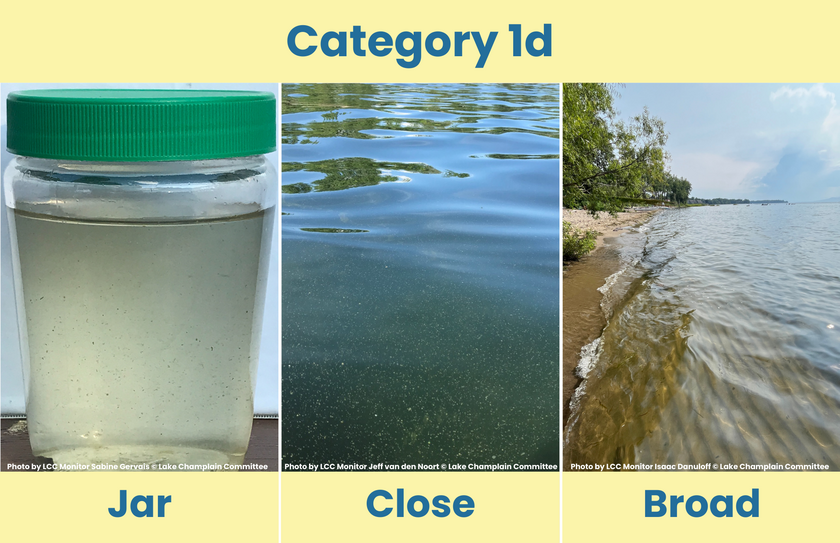
Category 2: Cyanobacteria present, but at less than bloom levels—include photos
Some cyanobacteria accumulation in the water column or on the surface, but not a continuous layer.
What you may observe:
- Open water does not appear green, blue, or blue-green
- Streaks of cyanobacteria on the water surface, but not a continuous layer
- Small patches of cyanobacteria on the water surface, but not a continuous layer
- A narrow band of cyanobacteria accumulation at the shoreline
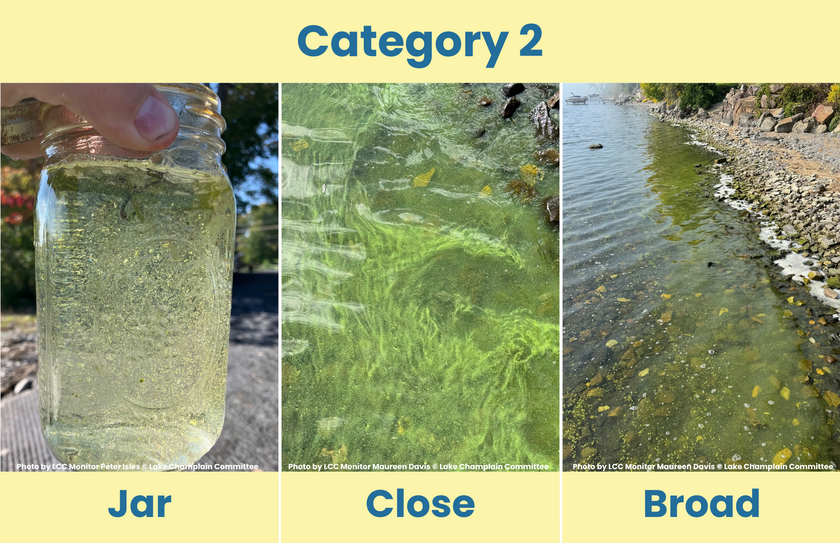

Category 3: Cyanobacteria bloom in progress—include photos
Extensive cyanobacteria accumulation in the water column or on the surface, forming a continuous layer.
What you may observe:
- Open water does appear green, blue, or blue-green
- Continuous layer of surface scum on the water
- A wide band of cyanobacteria accumulation at the shoreline that extends at least 10-15 feet offshore
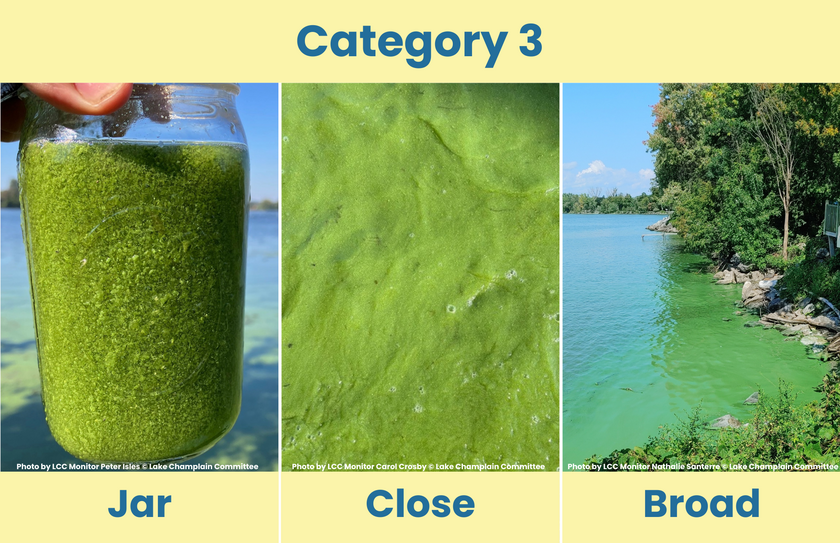
While all blooms in this category indicate a high density of cyanobacteria, they can appear differently based on factors like water movement, bloom density, and cyanobacteria species. It's also common to observe combinations of these types within the same bloom, as environmental conditions can create mixed patterns. Below are the primary types of Category 3 cyanobacteria blooms that you may observe:
- Green Water
- Striations
- Spilled Paint
- Scum
- Globules
- Speckled
- Dried Crust
Green Water
What you may observe:
- Water appears uniformly green, ranging from pale green to dark green.
- No distinct streaks, patches, or scum visible; the color is evenly dispersed.
- Can give the appearance of dyed or murky water.
- Often occurs in calm, nutrient-rich areas.
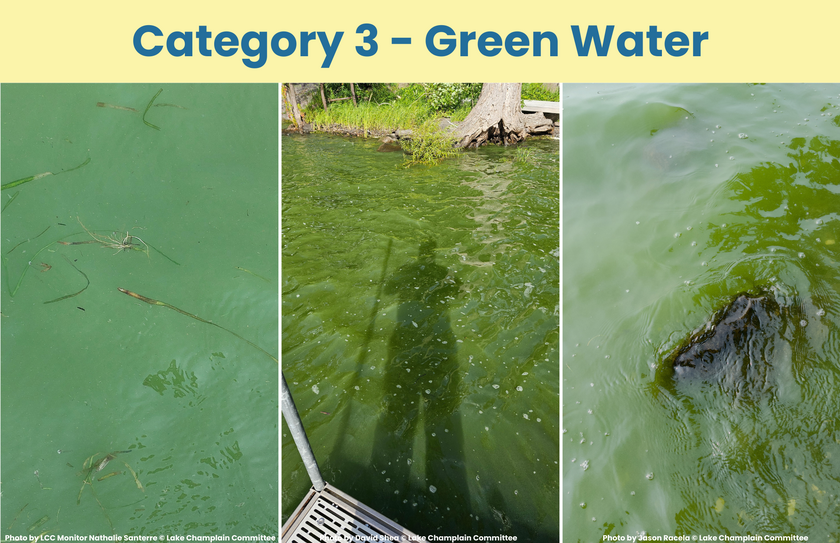
Striations
What you may observe:
- Cyanobacteria form linear streaks or bands across the water surface.
- Alternating patterns of denser cyanobacteria and clearer water.
- Water currents or wind patterns visibly influence the alignment of the bloom.
- Found in open water, near docks, or along flowing river systems.
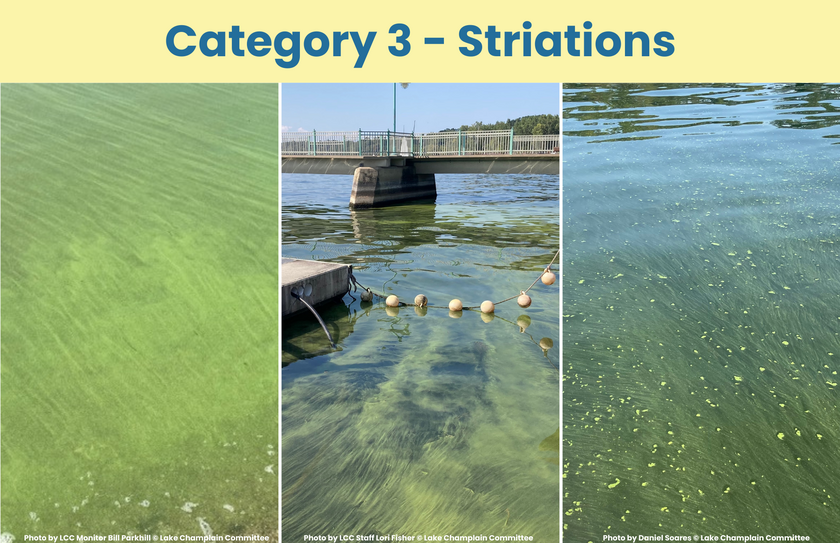
Spilled Paint
What you may observe:
- Water surface appears smooth and opaque, resembling spilled paint.
- Dense, continuous coverage of vibrant green, blue-green, or teal colors.
- Little to no visible texture or separation in the bloom.
- Typically accumulates in calm areas, such as bays or along sheltered shorelines.
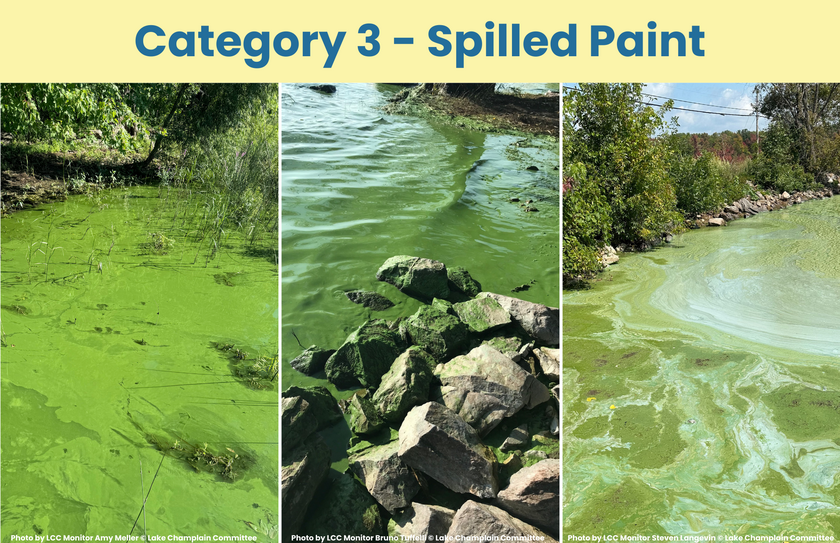
Why are some paint spill blooms teal?
Teal blooms are a specific type of "spilled paint" cyanobacteria bloom, characterized by their striking teal or blue-green coloration. This unique color is due to the release of phycocyanin, a pigment found in cyanobacteria. Phycocyanin becomes more visible when the chlorophyll in the cells begins to degrade, often during the later stages of a bloom or as the cells start to decay.
Teal blooms are commonly associated with calm, nutrient-rich waters and can accumulate along shorelines or in sheltered areas. They may also indicate a high density of cyanobacteria, as well as cell breakdown and the potential for toxin release.
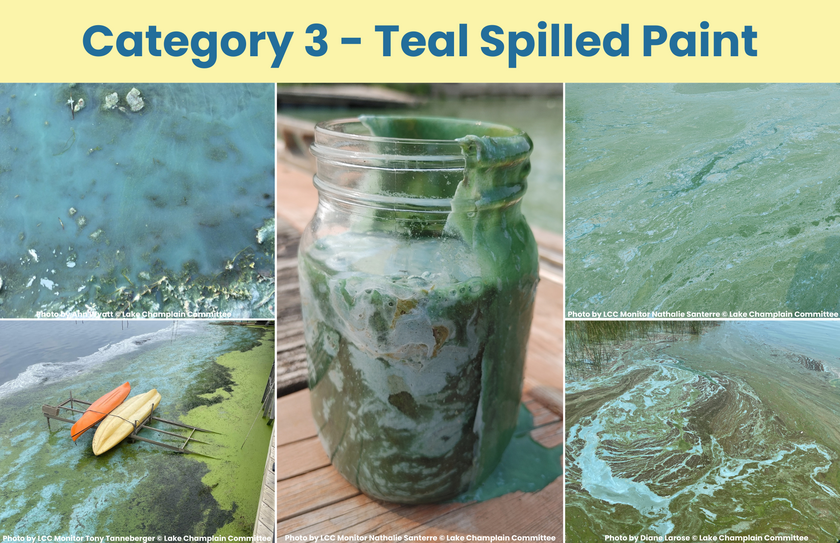
Scum
What you may observe:
- Thick, foamy, or gelatinous layers floating on the water surface.
- Often bright green, blue-green, or yellow, with a shiny or slimy appearance.
- Accumulates along shorelines, in corners of water bodies, or in stagnant areas.
- May emit an unpleasant odor as it decays.
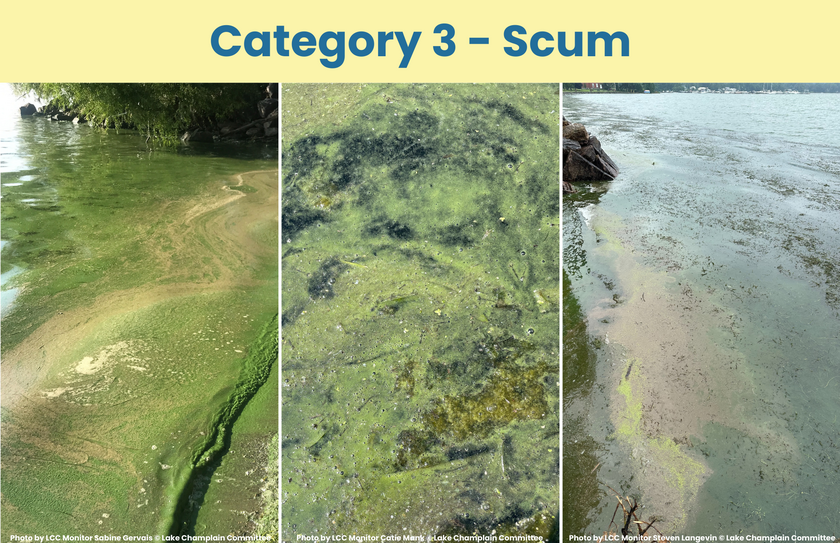
Globules
What you may observe:
- Small, round clumps or globules floating within the water column or on the surface.
- Typically green or blue-green, with a jelly-like consistency.
- Can appear suspended beneath the surface or aggregated in patches.
- Common in still water with high cyanobacteria densities.
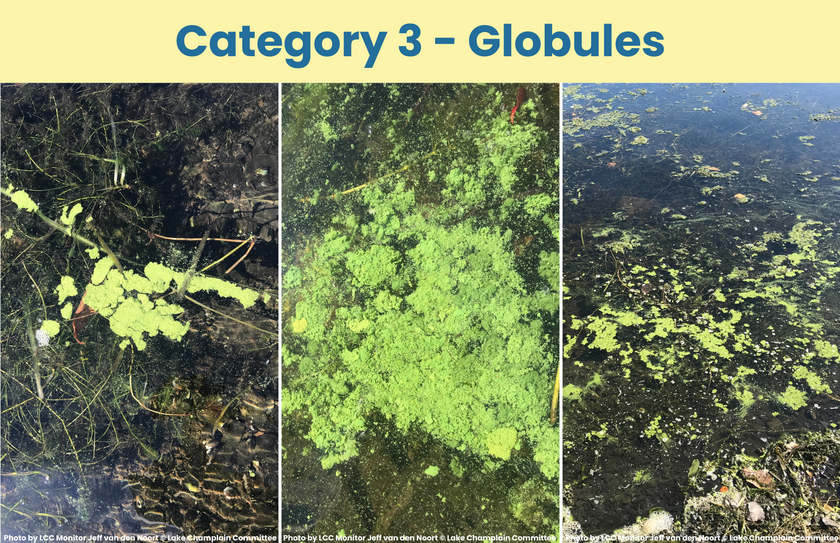
Speckled
What you may observe:
- Concentrated amount of specks or fuzzy balls floating throughout water column
- Often green or yellow-green, with powder-like appearance
- Visible separation between specks but can present even dispersal
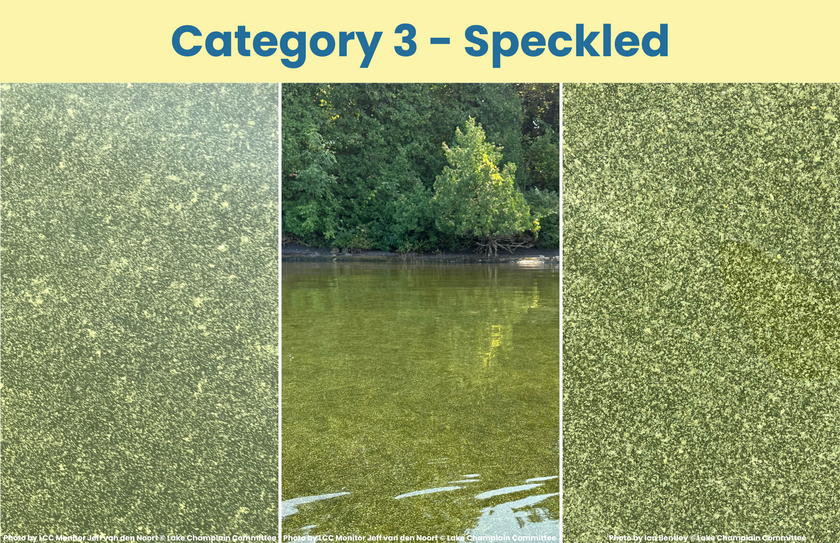
Dried Crust
What you may observe:
- Cyanobacteria that have dried along shorelines or on exposed surfaces.
- Appears as a flaky, crusty layer, often green, brown, or black.
- Found on rocks, sand, or vegetation exposed to air after water levels drop.
- May release a musty odor when disturbed.
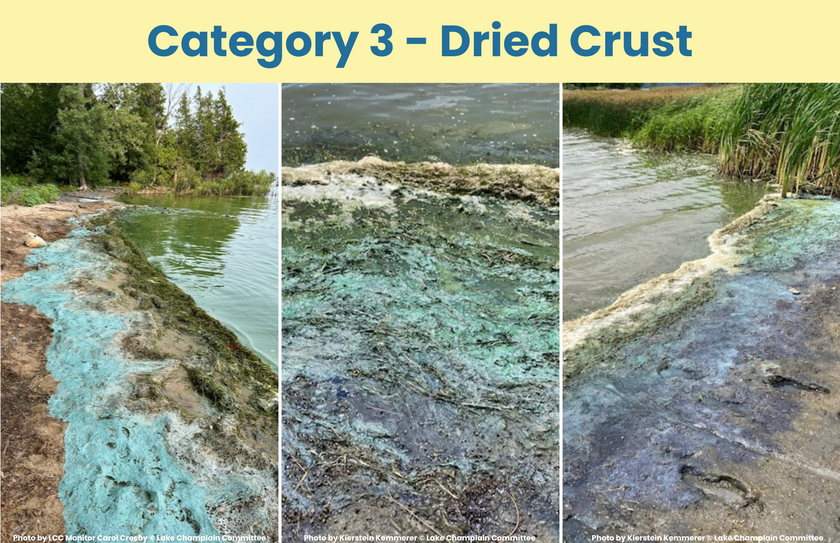
Category 3 cyanobacteria blooms can present a wide variety of colors, ranging from brown and yellow to vibrant green and teal. These colors are influenced by the pigments within the cyanobacteria, environmental factors, and the stage of the bloom. Observing bloom color can provide clues about its density, composition, and whether decay processes are occurring, with teal hues often indicating the release of phycocyanin during cell breakdown.

Jar Test of Each Category
- The jar test line-up compares and contrasts the six bloom intensity categories: 1a, 1b, 1c, 1d, 2, and 3. View instructions for taking water samples here.
